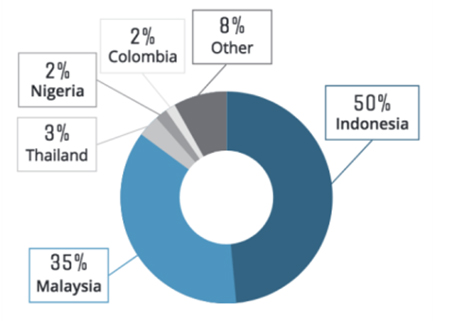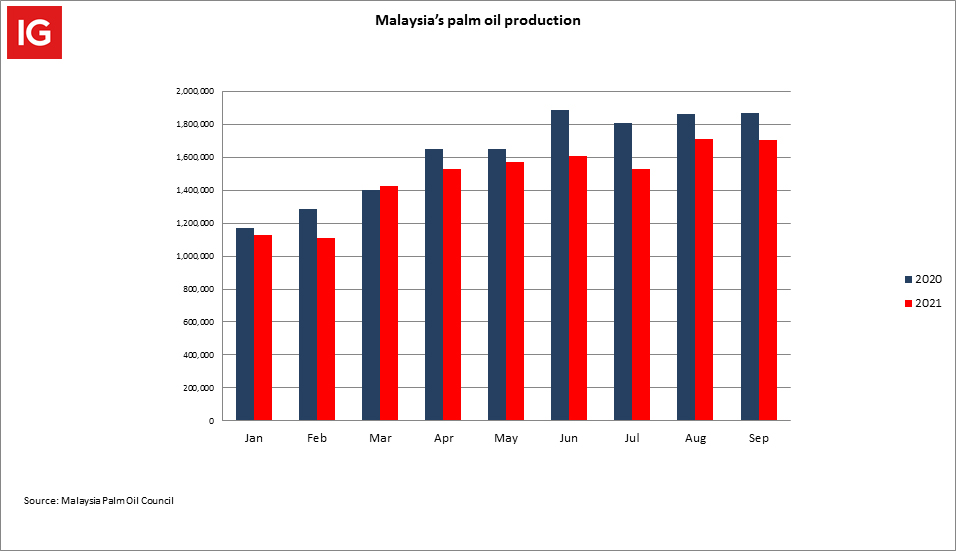
Like many commodities, palm oil has enjoyed an excellent year in 2021. Its price more than doubled over the past 18 months, especially from June to October, when an incredible 50% surge sent it to its all-time high at RM5074 per ton.
The escalated shortage in production and soaring global demand are what fuelled market appetite to notch fresh records. What also caught our eye is that this was achieved despite the shakeup in Q3, when commodities like crude oil tumbled. However at this moment, it's understandable that investors are confronted with mixed emotions- is the growth sustainable? How high can it go?
Palm oil vs crude oil
Palm oil in 2021: a widening gap between supply and demand
Since 1980, global palm oil production has been dominated by two countries - Indonesia (60% of output, based on 2020 data) and Malaysia (24%, based on 2020 data), which collectively account for 84% of the global palm oil supply. The Global palm oil market has been growing steadily for the past decade and is forecast to reach US$57.2 billion by 2026, driven by the growing demand for vegetable oil, food-related packaging and bioenergy.
However, a series of challenges for this industry, particularly those caused by the pandemic, saw the world's most consumed edible oil output decline considerably this year. As reported by the Malaysian Palm Oil Board (MPOB) and the US Department of Agriculture, it's estimated that the annual production of palm oil will drop from 19.7 million tonnes a year ago, to less than 18 million by the end of 2021. If this happens, that would be the lowest annual volume since 2016. Indonesia, the largest producer of palm oils is also facing production issues, with production volumes failing to meet the target in Q3- the period when output normally peaks.
A major hurdle for palm oil production in Malaysia is labour shortage. Foreign workers, who account for about 70% of the 500,000 people employed on Malaysian palm oil estates, have been shut out of the country and unable to return to plantations, due to border restrictions since the start of pandemic. A current survey by MPOB revealed that Malaysia's palm oil estates had a labour shortage 31,021 employees in April 2021. Flooding, unfriendly weather and logistical issues have also slowed production across the two largest producers this year.
On the demand side, India has traditionally been one of the biggest palm oil markets globally. However, despite rising COVID-19 cases causing widespread closure of food services where palm oil demand high, the demand has shown a strong rebound since July 2021. In addition, China (14% of global demand), Pakistan, the United States, and Bangladesh all indicated a growing appetite for palm oil, compared to last year. As a result, it came as no surprise when Malaysia's palm oil exports showed a 37% month-on-month increase in September, despite prices hitting record levels.
Palm oil in 2022: opportunities and challenges
Coinciding with pent-up demand as economies reopen, the widening gap between the supply and demand has underpinned the skyrocketing price of palm oil this year. The outlook for now- given the persistence of production hurdles and global inflationary risks - is well positioned to continue its legend as a global super-commodity well into the next year, at least for Q1.
Adding to that, Indonesia's plan to halt its export of raw palm oil, in a bid to attract investment in the country's resource processing capabilities and create jobs is expected to be a game-changer for the new year ahead. Although Indonesia will be able to export more refined palm oil, instead of crude palm oil under the planned reform, the demand for crude palm oil will undoubtedly push buyers to the Malaysian product, consequently driving the price upwards.
However, there are also challenges and uncertainty for palm oil in 2022. The EU has announced plans to end palm oil imports from Indonesia and Malaysia to reverse deforestation by 2030. India, the top buyer of vegetable oils of, introduced stock limits on edible oils on 10 October, to regulate how much inventory wholesalers and retailers can carry.
On the other hand, palm oil supply may also improve over the second quarter due to easing of labour shortages in Malaysia with 32,000 foreign workers being allowed back to work.
How to trade crude palm oil?
As one of the most popular edible oils to enjoy solid global demand, palm oil has delivered a robust year with over 76% growth for the first nine months, and its ongoing bullish momentum will likely to continue into the new year. Meanwhile, industry labour supply, policy changes, and the climate-related agenda will be the three key areas to keep a close eye on for this super commodity in the 2022. To seize opportunities in palm oil, IG International offers palm oil CFDs with up to 10 times more leverage and the flexibility to go long or short on mini contract sizes of MR2.5.
Through our trading platforms, you can access 35 commodities, or a range of commodity stocks and ETFs. You can also see live market updates with our in-platform newsfeeds, in order to take full control of your deals and analysis. Our award-winning platforms have been recognised time and time again by the industry. 1
Visit IG to find out more about trading crude palm oil (CPO) and IG's award winning platform.
1 Awarded Best Finance App and Best Multi-Platform Provider at the ADVFN International Financial Awards 2020.
The risks of loss from investing in CFDs can be substantial and the value of your investments may fluctuate. CFDs are complex instruments and come with a high risk of losing money rapidly due to leverage. You should consider whether you understand how this product works, and whether you can afford to take the high risk of losing your money.
CFD Accounts provided by IG International Limited. IG International Limited is licensed to conduct investment business and digital asset business by the Bermuda Monetary Authority.
IG provides an execution-only service. The information in this article does not contain (and should not be construed as containing) investment advice or an investment recommendation, or an offer of or solicitation for transaction in any financial instrument. No representation or warranty is given as to the accuracy or completeness of the above information. Consequently, any person acting on it does so entirely at his or her own risk. The information does not have regard to the specific investment objectives, financial situation and needs of any specific person who may receive it. IG accepts no responsibility for any use that may be made of these comments and for any consequences that result.
The information in this article is not directed at residents of the United States and is not intended for distribution to, or use by, any person in any country or jurisdiction where such distribution or use would be contrary to local law or regulation.
IG International Limited is part of the IG Group and its ultimate parent company is IG Group Holdings Plc. IG International Limited receives services from other members of the IG Group including IG Markets Limited.
Read this article in Chinese





